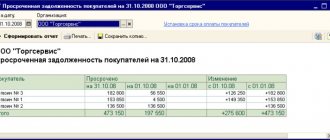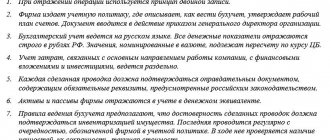What is included in account 97?
Current accounting regulations provide for the reflection of two types of costs in deferred expenses (FPR):
- expenses incurred in connection with upcoming work under construction contracts (clause 16 of PBU 2/2008). For example, this may include the cost of materials that were transferred for construction work but have not yet been used, or rent for future periods that were transferred in the reporting period;
- payments for the granted right to use the results of intellectual activity or means of individualization. In this case, these payments must be made in the form of a fixed one-time payment (clause 39 of PBU 14/2007). Here you can list the non-exclusive right to use a computer program, invention, brand name, etc. (Article 1225 of the Civil Code of the Russian Federation).
If an organization has incurred other expenses, the accounting procedure for which is not regulated, and the organization believes that such expenses relate to several reporting periods, they can also be taken into account as RBP and distributed between the reporting periods to which the costs relate, in the manner established by the organization (evenly , proportional to the volume of production, etc.) (Letter of the Ministry of Finance dated January 12, 2012 No. 07-02-06/5). For example, these could be the costs of product certification.
Where deferred expenses apply
Not so.
Even without taking into account the Chart of Accounts, which still has a valid account 97, direct mention of deferred expenses is available in the following regulatory accounting documents: - clause 39 of PBU 14/2007 “Accounting for intangible assets”; — clause 16 PBU 2/2008 “Accounting for construction contracts”; — clause 94 of the Guidelines for accounting of inventories; — clause 16 of the Guidelines for the preparation of financial statements when reorganizing organizations.
In addition, PBU 10/99 “Organizational Expenses” retains the basic principles for the very existence of future expenses.
Clause 9 of PBU 10/99 states that for the purposes of the organization’s formation of the financial result of ordinary activities, the cost of goods, products, works, services sold is determined, which is formed on the basis of expenses for ordinary activities recognized both in the reporting year and in previous reporting periods, and carryover expenses related to the receipt of income in subsequent reporting periods. Clause 19 of PBU 10/99 establishes that expenses are recognized in the profit and loss statement, in particular, taking into account the relationship between expenses incurred and revenues, as well as through their reasonable distribution between reporting periods, when expenses determine the receipt of income over several reporting periods and when the relationship between income and expenses cannot be clearly determined or is determined indirectly. So do deferred expenses exist in principle or not? Should I use account 97 or should I forget about it forever?
Accounting on account 97
Accounting account 97 is an active account. The occurrence of RBP is reflected in the debit of this account, and their write-off is reflected in the credit.
Depending on the type of costs recognized as deferred expenses, the debit entries in account 97 may be as follows (Order of the Ministry of Finance dated October 31, 2000 No. 94n):
Debit of account 97 – Credit of accounts 10 “Materials”, 60 “Settlements with suppliers and contractors”, 76 “Settlements with various debtors and creditors”, etc.
Accordingly, the write-off of RBP, i.e. their recognition as expenses of current periods, can be reflected as follows:
Debit of accounts 20 “Main production”, 26 “General business expenses”, 44 “Sales expenses”, etc. – Credit of account 97
In the balance sheet, RBP, depending on their nature, can be reflected as part of non-current assets on line 1190 “Other non-current assets” or as part of current assets on line 1210 “Inventories”. Long-term RBP will be reflected when the period of their write-off exceeds 12 months after the reporting date (Letter of the Ministry of Finance dated January 27, 2012 No. 07-02-18/01). If the value of the RBP is significant in the financial statements, they are presented separately (clause 11 of PBU 4/99, Appendix to the Letter of the Ministry of Finance dated January 29, 2014 No. 07-04-18/01).
It may be noted that in cases where the provisions of the Tax Code of the Russian Federation require the gradual recognition of any costs during reporting periods, and the accounting rules do not prohibit taking into account these costs as part of the RBP, in order to bring accounting and tax accounting closer together, such costs can be reflected in account 97.
If it is necessary to spend funds on assets, economic benefits from which can only be obtained in upcoming reporting periods, such amounts are charged to accounting account 97. Gradually, the costs are transferred from it to the cost of objects. Legislatively, the list of cost items for assigning them to future periods is limited to two categories, but the accountant is given the opportunity to use the account in cases where a specific cost option is not prescribed in the Accounting Regulations.
Reflection in the balance sheet of deferred expenses
Provisions are made for assets that, when assessed, do not have a carrying amount at a specific date.
Often, advances to suppliers on items such as materials and equipment lose value as receipt of goods is extended over a long period of time.
Let's assume that a company has provided an advance to a foreign entity for a significant amount to purchase equipment. The advance was made about a year and a half ago. The equipment has not yet been received as it is currently held by customs and ownership has not yet transferred to the company purchasing the equipment. Although the company expects to receive the equipment within the next year, the value of the equipment has decreased due to delays at customs and changes in market conditions, so a reserve must be created for such equipment.
3. Information requirements
To ensure that the accounting policies applied by a Russian entity and the accounting policies that must be followed for the purposes of compliance with IAS are the same for deferred expenses and other assets, the following information should be obtained.
- A detailed analysis of account 31 “Deferred expenses”, account 61 “Settlements for advances issued”, accounts 71 and 73 “Settlements with accountable persons” and “Settlements with personnel for other operations”, account 76 “Settlements with various debtors and creditors”, and data on the status of accounts related to settlements for taxes with the budget, for payments to extra-budgetary funds and for settlements for social insurance and security (accounts 19, 67, 68, 69), for each significant item in order to determine the following:
3. Eliminate differences
Below is an example of correct accounting for deferred expenses.
If the insurance policy premium is paid in advance for the entire insurance period, an asset is created. Over time, the value of an asset declines and part of its value is expensed. On August 1, 1996, Utyug OJSC made an advance payment on a one-year insurance policy in the amount of RUB 7,200,000. The asset currently exists because possible benefits—insurance coverage—will be received in the future. To properly record the transaction, the following entry is used:
August 1, 1996
| D-t | Prepaid Insurance | 7,200,000 |
| Kit | Cash register | 7,200,000 |
In preparation for closing the books on August 31, 1996, the accounting department will determine the insurance expenses relating to August: (1/12) of the original cost of the prepaid policy.
August 30, 1996
| D-t | Insurance costs | 600,000 |
| Kit | Prepaid Insurance | 600,000 |
print version
Using account 97 in accounting in 2018
As directly stated in paragraph 16 of PBU 2/2008, deferred expenses include those expenses that were incurred to provide planned work or expected services. To take them into account, accounting account 97 is used for this. Upon recognition of revenue for tax and accounting purposes, they will be written off to determine the financial result.
Let's look at examples of what future expenses can be attributed to account 97:
- an operation for the purchase of building materials that have not yet been used;
- rent paid in advance;
- those related to preparation for seasonal work;
- expenses for the development of new production facilities;
- costs for the reclamation of agricultural land, which will be included in the cost of cultivated products for many years to come;
- irregular repairs of fixed assets during the year, if the enterprise has not created an appropriate reserve for this type of expenditure;
- in agriculture - these are the costs of constructing temporary non-capital structures for production purposes;
- procurement of agricultural products for the purpose of their subsequent processing in the off-season.
In addition to the costs listed above, account 97 deferred expenses in 2020 also reflects the licensee’s costs of paying a fixed one-time payment for the right to use intangible assets (clause 39 of PBU 14/2007). Subsequently, these expenses will be written off in equal parts over the term of the contract.
How to reflect data on account 97 in the balance sheet
The rationale for this position is given below in the materials of the Glavbukh System
1. Article: What should now be considered expenses of future periods, and what should be written off immediately
But in the new accounting forms, it will no longer be possible to reflect, in particular, expenses of future periods as a separate line. As you remember, in the old balance sheet form in the “Inventories” section there was a line called “Deferred expenses”. Now it has been removed. You can easily determine where to reflect this or that asset (expense) in the reporting using the table.
How should former deferred expenses now be reflected in the financial statements?
| Costs previously accounted for as deferred expenses | Line (substring) in reporting |
| Non-exclusive rights (license) to use computer programs* (fixed one-time payment), including if: - the period of use of the program is more than 12 months; - the period of use of the program is 12 months or less | Line 1170 “Other non-current assets” of section I of the balance sheet. If the amount is significant - the substring “Rights to use software”. Line 1210 “Inventories” of section II of the balance sheet.* If the amount is significant - subline “Rights to use software” |
| Expenses for upcoming work under a construction contract | Line 1210 “Inventories” of Section II of the balance sheet. If the amount is significant - subline “Costs for upcoming work under construction contracts” |
| Lease payments, including if: - paid for more than 12 months; - paid for 12 months or less | Line 1230 “Accounts receivable” of section II of the balance sheet. Substring “Long-term receivables.” Substring “Short-term receivables” |
| One-time payments under insurance contracts, including if: - the term of the insurance contract is more than 12 months; - the term of the insurance contract is 12 months or less | Line 1230 “Accounts receivable” of section II of the balance sheet. Substring “Long-term receivables.” Substring “Short-term receivables” |
| Expenses for long-term repairs of fixed assets, including if: - the objects are involved in the main production; - the objects are not directly involved in the main production | Line 2120 “Cost of sales” of the Profit and Loss Statement. Line 2220 “Administrative expenses” of the Profit and Loss Statement |
| Costs of obtaining a license for any type of activity | Line 2120 “Cost of sales” of the Profit and Loss Statement. In case of adjustment of account 97 at the beginning of the year, it is necessary to fill out section 2 “Adjustments due to changes in accounting policies” of the Report on changes in capital (in annual reporting) |
| Start-up and preparatory expenses, including if: - related to the main production; - not related to the main production | Line 2120 “Cost of sales” of the Profit and Loss Statement. Line 2220 “Administrative expenses” of the Profit and Loss Statement |
| Part of vacation pay due in the next month | Depending on which department employee goes on vacation, in the Profit and Loss Statement use lines 2120 “Cost of sales”, 2210 “Commercial expenses” or 2220 “Administrative expenses” |
What you need to do
First, decide whether you need to change anything at all in accounting for deferred expenses.
If your company is small and you keep accounting “for show” - just to report to the tax office and the statistics department, there is no point in wasting your precious time on perfect accounting.
* Yes, hypothetically, for incorrectly reflecting business transactions on the company’s accounts, they face fines under Article 120 of the Tax Code of the Russian Federation. But it is unlikely that auditors from the Federal Tax Service will look at the balances of account 97 and delve into their accounting essence, because they do not affect the calculation of taxes in any way.*
Important detail
If you don’t strive for perfect accounting, you don’t have to “clear” account 97 and leave everything as is. Just don’t forget to sort the amounts into specific lines on the balance sheet (inventories, accounts receivable).
Therefore, you can leave everything as is in account 97. However, when filling out the balance sheet, you will still have to sort the amounts by specific lines: be it “Inventory”, “Other non-current assets” or “Receivables”.
Magazine "Glavbukh" No. 14, July 2011
2. Directory:
Procedure for filling out the Balance Sheet
The form of the Balance Sheet was approved by Order of the Ministry of Finance of Russia dated July 2, 2010 No. 66n.
| Name of balance sheet items | Line code 1 | Accounting accounts (in particular) |
| II. Current assets | ||
| Reserves* | 1210 | Account balance: – 10 “Materials” – 11 “Animals for growing and fattening” – 20 “Main production” – 21 “Semi-finished products of own production” – 23 “Auxiliary production” – 29 “Service production and farms” – 41 “Goods” (minus the credit balance on account 42 “Trade margin”, if goods are included in sales prices) – 43 “Finished products” – 44 “Sales expenses” – 45 “Goods shipped” – 46 “Stages completed for work in progress” – 97 “ Deferred expenses" (except for expenses reflected on lines 1110 and 1150 of the balance sheet)* - 15 "Procurement and acquisition of material assets" - plus (minus) debit (credit) balance on account 16 "Deviation in the cost of material assets" - minus credit balance on account 14 “Reserves for reduction in the value of material assets” |
| Other current assets | 1260 | Account debit balance: – 50 “Cash” (in terms of the balance in the “Cash Documents” sub-account) – 79 “Intra-business settlements” (in terms of settlements under the property trust management agreement) – 94 “Shortages and losses from damage to valuables” – other negotiable assets not reflected in other groups of items in the “Current assets” section |
3. Article:
What colleagues argue about.
On which account should the electronic signature be reflected: 97 or 26? If the fee for the certificate and program is significant for the company, then its cost should be reflected in account 97. And then written off as expenses in equal shares during the period of use.
Then the balance of the payment made but not yet written off for the key will fall into line 1210 “Inventories” of the balance sheet (clause 20 of PBU 4/99, approved by order of the Ministry of Finance of Russia dated 07/06/99 No. 43n).
* If such expenses are not significant for the company, then you can write off the entire fee for the electronic key at a time. Moreover, the materiality of expenses is an estimated value, and the company has the right to determine it itself.
Magazine “Accounting. Taxes. Law" No. 12, March 2014
Best regards, Natalya Kolosova,
Your personal expert.
_____________________________
The answer to your question is given in accordance with the rules of expert support, which you can find at: https:// vip.1gl.ru/#/hotline/rules/
Detailed breakdown of all balance sheet lines
Source: https://www.glavbukh.ru/hl/83944-kak-otrajat-dannye-na-schete-97-v-buhgalterskom-balanse
Features of attributing costs to account 97
On the account 97, in addition to those described above, also displays costs that, according to the requirements of the Tax Code, must be written off over several reporting periods. They can be displayed as part of deferred expenses in order to bring tax and accounting closer together, if this does not contradict the accounting rules.
This is, for example, a payment for certification of manufactured products or a one-time payment for the use of a trademark. It is better to register such cases in the accounting policy of the enterprise.
And although there is no concept of deferred expenses in tax accounting, in fact they exist. These are expenses that are not immediately reflected in accounting, but are systematically written off in equal parts over a specified period (clause 3 of Article 268, clauses 1 and 6 of Article 272, clause 2 of Article 261, clause 9 of Article 262 of the Tax Code RF). The enterprise establishes the methodology for distributing expenses independently, or it is mentioned in the terms of the transaction in accordance with clause 1 of Art. 272 NK.
However, some costs cannot be deferred, even if they are made in advance. In particular, advances issued and expenses for subscriptions to periodicals are not reflected in account 97. Payment of vacation pay also does not apply to deferred expenses - an appropriate reserve is created for this.
Score 97
Check employee salaries with the new minimum wage.
From 05/01/2018, the federal minimum wage will be 11,163 rubles, which is 1,674 rubles more than now. This means that employers who pay their employees at the minimum wage must raise their wages from May 1. < … >
It is impossible to issue a copy of the SZV-M to a resigning employee.
According to the law on personal accounting, when dismissing an employee, the employer is obliged to provide him with copies of personalized reports (in particular, SZV-M and SZV-STAZH). However, these reporting forms are list-based, i.e. contain information about all employees. This means transferring a copy of such a report to one employee means disclosing the personal data of other employees. < … >
Online cash register: who can take the time to buy a cash register
Individual business representatives may not use online cash register until July 1, 2019. However, for the application of this deferment there are a number of conditions (tax regime, type of activity, presence/absence of employees). So who has the right to work without a cash register until the middle of next year? < … >
Account 97: postings
Synthetic account 97 is active. The debit shows the expenses incurred by the enterprise for future periods. The loan is written off in accordance with accounting rules. This can be seen more clearly by familiarizing yourself with the typical 97 transactions for account:
Dt 97 Kt 60 - expenses for settlements with suppliers for services rendered are taken into account;
Dt 97 Kt 76 - displays settlements with creditors for the supply of goods in terms of deferred expenses;
Dt 97 Kt 10 - deferred expenses are taken into account when purchasing materials;
Don't know your rights? Subscribe to the People's Adviser newsletter. Free, minute to read, once a week.
Dt 97 Kt 02 (05) - reflects depreciation on fixed assets (intangible assets), which relates to future periods;
Dt 08 Kt 97 - inclusion in the initial cost of fixed assets;
Dt 20 Kt 97 - partial allocation to the cost of production;
Dt 25 Kt 97 - write-off for production costs;
Dt 26 Kt 97 - write-off of costs for using software;
Dt 44 Kt 97 - write-off for expenses associated with the sale of goods.
The procedure and frequency of writing off future expenses to cost is determined by each enterprise independently - it is better to consolidate them in the accounting policy. For example, expenses can be written off in equal parts over the period established by order of the manager or as a percentage of revenue. This is stated in the letter of the Ministry of Finance dated January 12, 2012 No. 07-02-06/5.
To avoid problems with writing off future expenses in accounting, it is recommended to maintain analytical accounting in the context of each type of such expense.
Typical accounting entries for account 97
The PBU presents the following typical transactions for account 97:
| Debit correspondence | Loan correspondence | the name of the operation |
| 97 | (60) | Costs recorded as deferred expenses |
| (26, 44, 91) | 97 | Share of BPR included in expenses but attributable to a future period |
Account 97 is active, financial and distribution. Analytical accounting of the account is carried out in the context of each type of expense. The balance sheet does not have a separate line for account 97, so the data on it is included in the section of current assets or inventories - line 1210 or 1260.
In which section and by which line number in the balance sheet is account 97 reflected?
According to paragraph 65 of Order No. 34n of the Ministry of Finance dated July 29, 1998, expenses incurred by the enterprise in the reporting period, but in order to ensure activities in future periods, are reflected in the balance sheet in accordance with the rules for recognizing assets. In which section of the balance sheet is account 97 reflected? In the asset.
In the balance sheet, account 97 is reflected on line 1190 (1110 - related to intangible assets, 1115 - to fixed assets) or 1210 (inventories), depending on the nature of the expenses (non-current or current). In the balance sheet, deferred expenses are taken into account in the amount of the debit balance (the balance of unwritten expenses) formed at the end of the reporting period (letter of the Ministry of Finance dated 06.06.2013 No. 07–01–06/21876).
As indicated in the recommendations from the letter of the Ministry of Finance dated January 27, 2012 No. 07–02–18/01, short-term deferred expenses should include those whose repayment period is less than 12 months. All others must be shown as long-term.
If the amount of future expenses is quite large, they should be displayed separately (clause 11 of PBU 4/99).
***
Deferred expenses are those necessary expenses that an enterprise makes in the reporting period in order to ensure its long-term activities. These include, for example, the cost of improving fixed assets that will be used and generate profit in the future. Such expenses arise especially often for enterprises engaged in seasonal activities. Deferred expenses are accounted for in account 97, and are written off as necessary to cost or included in other costs in order to determine the financial result.
Account 97 of accounting is an active account “Deferred Expenses”, designed to reflect information about deferred expenses of the enterprise: expenses incurred in the present period are written off in subsequent periods.
Score 97 - how it happened
Here's what it says about account 97 in the Chart of Accounts. Account 97 “Future expenses” is intended to summarize information about expenses incurred in a given reporting period, but relating to future reporting periods. In particular, this account may reflect expenses associated with mining and preparatory work; preparatory work for production due to its seasonal nature; development of new production facilities, installations and units; land reclamation and implementation of other environmental measures; repairs of fixed assets carried out unevenly throughout the year (when the organization does not create an appropriate reserve or fund), etc. <...> Analytical accounting for account 97 “Future expenses” is carried out by type of expense. The practical use of the account was even somewhat wider due to its convenience. Firstly, this account was often used to synchronize expenses between tax and accounting in order to avoid the appearance of temporary differences provided for in PBU 18/02 “Accounting for calculations of corporate income tax” (Approved by Order of the Ministry of Finance of Russia dated November 19, 2002 N 114n) . In the field of taxation, no international standards (with rare exceptions) are a decree for our state, and the distribution of incurred costs over several reporting periods is a common practice. Let us remember, for example, paragraph 3 of Art. 268 Tax Code of the Russian Federation. It says that if the residual value of depreciable property, taking into account the costs associated with its sale, exceeds the proceeds from its sale, then although the difference between these values is recognized as a taxpayer’s loss taken into account for tax purposes, the resulting loss should be included in the taxpayer’s other expenses in equal shares during the period defined as the difference between the useful life of this property and the actual period of its operation until the moment of sale.
In this case, in accounting, the loss from the sale of a fixed asset can be reflected in account 97 and written off simultaneously with its reflection in tax accounting. Methodologically incorrect, but extremely convenient. Secondly, this account could be used to adjust the expenses recognized in the current period . If, let's say, a company was called to the carpet by the tax office due to losses incurred and suddenly it had a profit, then most often this happened not because it was unexpectedly discovered that some expenses did not exist, but because these expenses smoothly moved to account 97. The same can be said about large one-time expenses in general: in order not to spoil the financial statements (if possible) and not to irritate its readers, the recognition of such expenses as expenses was extended over time. By the way, let us remind you that based on the Concept of the planning system for on-site tax audits (Approved by Order of the Federal Tax Service of Russia dated May 30, 2007 N MM-3-06 / [email protected] ), the presence of a loss is a sure way to invite tax authorities to your place for a documentary audit.
There are also purely technical benefits from using this account in computerized accounting, but these details can be left out of the equation. The claims of some experts regarding account 97 were that in the financial statements the balance on it was some kind of incomprehensible mixture. According to the author, this is not such a catastrophic flaw. If the amounts included in this mixture were significant, the reporting organization had to decipher them based on the requirements of clause 11 of PBU 4/99 “Accounting statements of an organization.”
What are “Deferred Expenses”
The concept of deferred expenses (FPO) has historically evolved from the need for organizations to capitalize their sunk expenses and investments in production prospects. These expenses are temporarily added to the capital of the enterprise and are included in the balance sheet asset. Subsequently, when written off in subsequent reporting periods, this capital goes to cost accounts.
In order for incurred costs to be classified as BPR, two conditions must be met:
- costs must be recognized as an asset;
- must relate to several periods.
There is a limited list of expenses that can be classified as BPR. These are the costs associated with:
- seasonality of work;
- mastering new technology and equipment;
- mining and preparatory work;
- land reclamation;
- environmental protection enterprises;
- OS repair (in the absence of reserve).
In practice, this account is used much more widely. Often, accountants send expenses to RBP in order to minimize temporary differences when calculating income tax, that is, they use this account to equalize accounting and non-accounting accounts.
In 2020, only two types can be classified as deferred expenses:
- for upcoming construction costs;
- for licensed software.
Expenses of the first type can be, for example, materials transferred to the construction site. To recognize construction expenses as a RBP, the following conditions must be met:
- the ability to reliably determine costs;
- During the period in which costs are incurred, there is also the possibility of concluding a contract.
Other expenses may also be included in deferred costs. The accountant, at his discretion, may classify expenses as those that need to be written off over a long period of time.
Advances transferred for the execution of some work do not apply to the RBP.
Deferred expenses in the balance sheet
How to reflect deferred expenses in the 1C Accounting 8.3 program?
In this article we will consider the question of how to take into account deferred expenses in 1C 8.3 “Enterprise Accounting 3.0”. RBPs in the 1C Accounting 8.2 program are reflected in the same way, so you can use this instruction for older versions of 1C.
Deferred expenses (FPR) are expenses that we took into account in the current period, but in this regard we plan to receive income in the future. In other words, you spent money today in order to receive income tomorrow.
Such expenses do not necessarily have a direct impact on profits. For example, we bought a domain (domain name) in order to deploy a website for our company. The purpose of the site is to attract customers who will generate income for us. Since the site must first be created and then “promoted,” it will begin to generate profit only after some time. The costs of purchasing a domain are deferred expenses.
Write-off of deferred expenses is carried out in three ways:
- monthly, within a certain date range
- daily (meaning calendar days), within a certain date range
- in an arbitrary (special) way. As a rule, this means a one-time write-off
These settings are specified in the reference book of the same name “Future Expenses”.
Let's start getting acquainted with taking into account future expenses with this reference book and filling it out.
Account 97 in accounting
The account is active and belongs to the group of financial distribution accounts. Analytical accounting on the account is carried out by type of expense. The Dt account collects all expenses, the Kt account includes financial accounts and accounts of material assets.
Postings to account 97 for RBP accounting
Typical correspondence 97 accounts:
Prospects for using account 97 in accounting
Since 2011, the concept of deferred expenses has not existed in the Russian accounting system, and a line with the corresponding name has been excluded from the balance sheet.
The gradually advancing process of convergence between RAS and IFRS led to the abandonment of the very concept of RBP, but account 97 in the Chart of Accounts still remained.
The main discrepancy is the fact that account 97 is in the balance sheet asset, while in fact it is a reflection of expenses. Account 97 is included in the section of current assets (line 1260) or inventories (line 1210).
Currently, one can imagine two scenarios for the development of events with a score of 97: complete refusal or continued use.
In the first case, all expenses attributed to account 97 should be reflected as current expenses. Transactions under construction contracts will be reflected as work in progress. Expenses for repairs of operating systems (in the absence of reserves) will need to be recognized in the period of actual repairs.
The costs of obtaining licenses will also have to be recognized as a lump sum at the time of actual payment.
This could be called a suitable and logical option, but the realities of our life are unlikely to allow us to achieve it. There are still a number of existing regulations and PBUs that operate with the concept of RBP. This means that, in accordance with them, the accountant will have to attribute expenses corresponding to these acts to account 97, despite the fact that they will not be reflected in Form-1, and in order to be included in its other lines, these expenses will require additional decoding.
In fact, we are moving towards a complete abandonment of the use of the BPO account. But since in practice it is used by organizations to align accounting and financial accounting, this is unlikely to happen soon, despite the assurances of the Ministry of Finance.
How is account 97 used in accounting?
In the debit turnover for account 97, all possible costs are formed. The credit must include financial and material values. Expenses temporarily incurred by the company become part of capital and remain on the balance sheet as an asset. In subsequent periods, funds are written off and become expenses.
To classify expenses as BPR, two important conditions must be met:
- The costs must be some type of active investment.
- Amounts must be formed over several periods.
The need to use such a concept as “deferred expenses” (FPR) arose as a result of the need for enterprises to invest money in promising production areas.
If we talk about specific types of expenses, then this includes the following areas:
- mastering new equipment or technology;
- mining and land works;
- seasonal work;
- repair work to restore the OS;
- licensing and possible construction costs.
In practice, the list of possible expenses is much larger.
The company's accountant may, at his discretion, classify as BPR expenses that need to be written off over a long period of time. However, advances that were paid for specific work are not taken into account here.
Deferred expenses in tax accounting 2016
The Tax Code of the Russian Federation does not define the concept of “future expenses”. But there are expense clauses that reduce the taxable base gradually over a period. These, in particular, include (Article 262, Article 272 of the Tax Code of the Russian Federation) costs:
- for insurance - voluntary medical, CASCO, OSAGO;
- for the acquisition of land;
- for research and development;
- to study natural deposits;
- for product certification.
In accordance with paragraph 1 of Art. 272 of the Tax Code of the Russian Federation, expenses in 2020 when calculating income tax are taken in the time period to which they are relevant for taxpayers who determine expenses and income on the accrual basis. The amount of expense is established taking into account the provisions of Art. 318-320 of the tax code.
The period to which the expenses incurred must be attributed is determined from the terms of the transaction. If there is no document by which it is possible to determine the distribution of expenses between income, then taxpayers establish a write-off method (uniformly, in proportion to the volume of production or income, etc.) independently and fix it in the accounting policy of the organization.
How to correctly reflect the peculiarities of accounting in the accounting policy, read the article “PBU 1/2008 “Accounting Policy of the Organization” (nuances)”.







